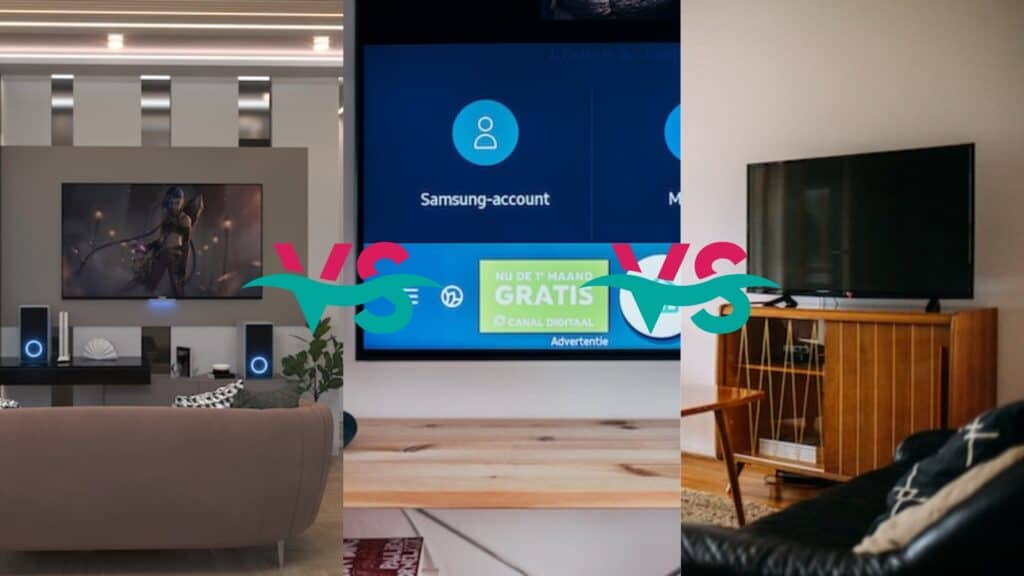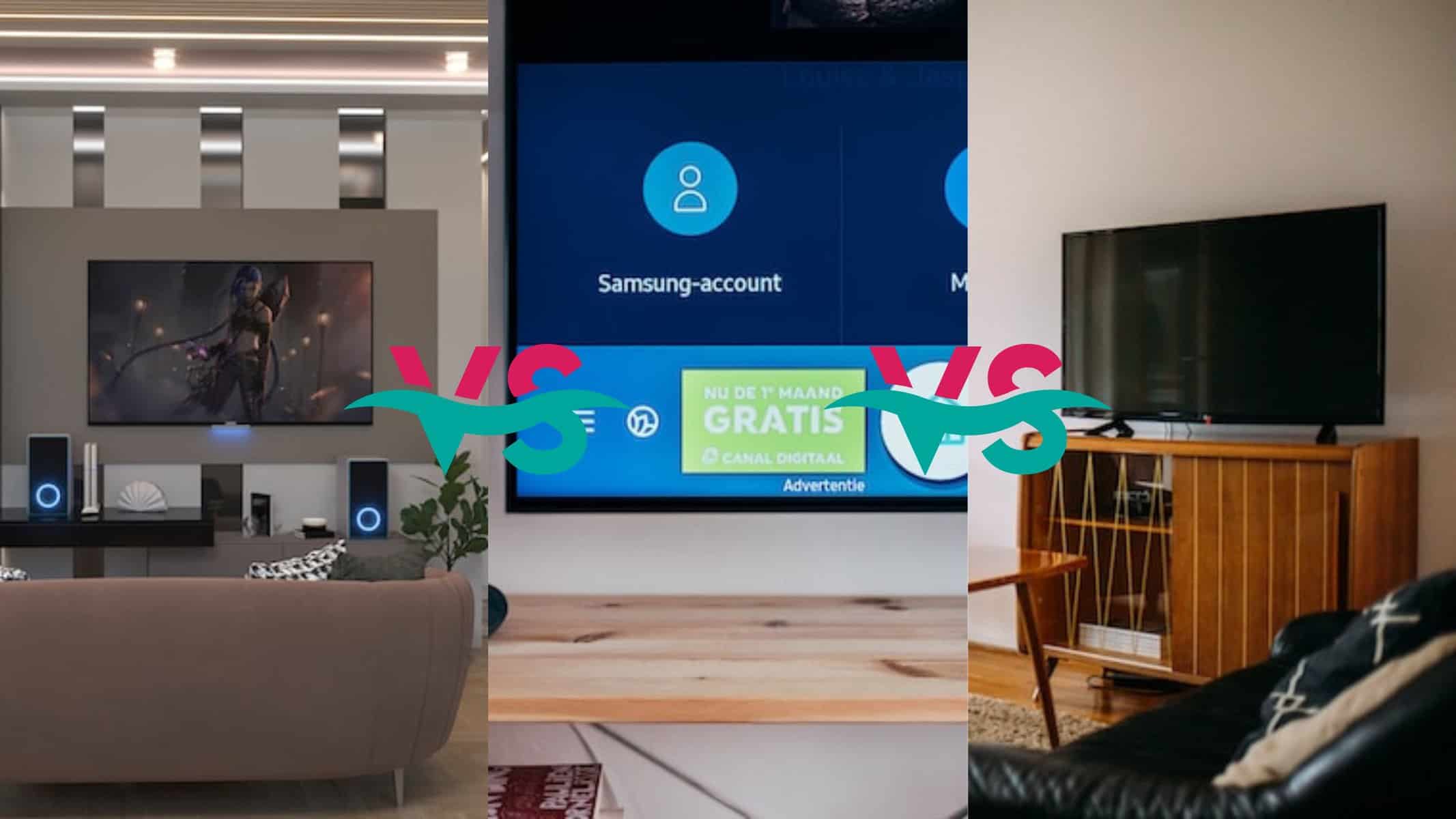Samsung QLED vs LG OLED vs Sony Bravia : The battle between Samsung QLED, LG OLED, and Sony Bravia TVs is intense. Each brand has its own unique features. Here, we’ll look into the details of these three giants. Then you can decide which reigns supreme!
Samsung QLED TVs are popular for their picture quality and colors. Quantum dot tech delivers stunning visuals. Plus, they have enhanced brightness and deep blacks for a captivating experience. AI upscaling algorithms optimize color and sharpness.
LG OLED TVs stand out for their contrast ratios and true black levels. Each pixel is illuminated individually, bringing dark scenes to life. Plus, they offer wide viewing angles.
Sony Bravia TVs have powerful processors. Image clarity and noise reduction are improved. X1 Ultimate Processor, Triluminos Display, and Motionflow XR make images come alive.
Which TV is right for you? Consider budget, lighting, usage, and screen size. Visit a showroom to experience the TVs firsthand. Don’t miss out on the next level of home entertainment bliss. Explore Samsung QLED, LG OLED, and Sony Bravia.
Brief overview of Samsung QLED technology
Samsung QLED technology is an advanced innovation driving the TV industry with its incredible visual performance. Movies, TV shows, and games are more alive than ever!
Features include:
- Quantum Dot Technology: Samsung QLED TVs use quantum dots to boost color accuracy and vibrancy. This produces a greater range of colors.
- High Peak Brightness: These TVs boast high peak brightness levels, making sure every detail is seen even in bright rooms.
- Ultra Viewing Angle: An ultra viewing angle feature ensures consistent colors and picture quality, no matter where you sit.
- Ambient Mode: Samsung QLED TVs have ambient mode which blends the screen with the background when not in use.
- Bixby Integration: You can control your Samsung QLED TV effortlessly with Bixby voice commands. Easily navigate through content.
- Sleek Design: These slim and sleek TVs add a touch of elegance to any living space.
Furthermore, Samsung QLED technology can reduce motion blur, making action-packed scenes smoother without losing clarity.
To get the most out of your Samsung QLED TV experience, adjust the settings to fit your preferences. Picture modes like contrast, brightness, and color temperature can improve visuals further.
Brief overview of LG OLED technology
LG OLED tech is a game-changer in display technology. It stands out with its picture quality that’s truly unparalleled. Deep blacks and bright colors make for an immersive viewing experience that captivates. The self-emitting pixels create infinite contrast, making images look realistic and detailed.
The TVs are also ultra-thin. They blend into any living space with ease. This sleekness adds a touch of elegance, giving the room a modern feel. AI ThinQ and webOS make navigating and voice control a breeze.
Tests and comparisons show LG OLED tech is top-notch. Its color reproduction, wide viewing angles, and motion handling are impressive. Whether for gaming or movies, it ensures a visually immersive experience.
Consumer Reports’ reliability survey in 2020 says LG is the most reliable TV brand. This shows how durable LG OLED tech really is.
Brief overview of Sony Bravia technology
Sony Bravia tech is a game-changer in the world of TVs. Its cutting-edge features and top-notch display quality make it stand out. Sony’s picture and sound engineering provide an immersive viewing experience.
These TVs have great resolution, bold colors, and deep blacks due to Sony’s Triluminos display tech. This widens the color gamut, creating an ultra-realistic visual experience. The X1 processor gives smooth motion and reduces noise for clear images.
Sony Bravia TVs also shine in audio performance. Acoustic Multi-Audio tech puts speakers at the back and front, producing a wider soundstage. This creates a more realistic audio experience that enhances the stunning visuals.
Sony Bravia TVs have the Android TV OS. This gives access to streaming services, apps, and Google Play Store. Plus, voice control with Google Assistant and Chromecast support.
Pro Tip: Boost your viewing experience with a high-quality soundbar for improved audio immersion.
Samsung QLED vs LG OLED vs Sony Bravia : Comparison of picture quality
Let’s look into the picture quality of Samsung QLED, LG OLED, and Sony Bravia. The three brands offer unique features and tech.
| Samsung QLED | LG OLED | Sony Bravia |
| Uses Quantum Dot tech for brighter colors. | Has self-lit pixels that switch on/off for perfect blacks. | X1 Ultimate processor for sharper details & color accuracy. |
| HDR capabilities for contrast & realistic visuals. | Dolby Vision support for HDR depth & dimensionality. | TRILUMINOS Display tech for vivid colors & lifelike accuracy. |
| Motion handling for smooth & clear images. | Perfect viewing angles without color/contrast deterioration. | Acoustic Surface Audio tech for immersive sound experience. |
Samsung QLED vs LG OLED vs Sony Bravia : Comparison of color accuracy
Color accuracy is essential when choosing a TV. It tells how true the colors look on the screen, for a better viewing experience. Let’s check out the color accuracy of Samsung QLED, LG OLED, and Sony Bravia TVs.
We looked at color reproduction, vibrancy, and consistency. Here’s a table that shows how each TV does:
| Samsung QLED | LG OLED | Sony Bravia | |
|---|---|---|---|
| Color Reproduction | Excellent | Outstanding | Impressive |
| Vibrancy | Vibrant | Rich | Lifelike |
| Consistency | Consistent | Uniform | Accurate |
It’s clear all three do great. Samsung QLED has excellent color reproduction and vibrancy. LG OLED is outstanding with rich vibrancy. Sony Bravia provides lifelike colors and accurate representation.
Plus, Samsung QLED has quantum dot technology for even more accuracy. This tech lets you control each pixel, so colors look sharper.
Tip: To get the best color accuracy, calibrate your TV. You can use professional tools, or get help from technicians who know calibration techniques. This will get you the most accurate colors on your screen.

Samsung QLED vs LG OLED vs Sony Bravia : Comparison of contrast ratio
The showdown between Samsung QLED, LG OLED, and Sony Bravia TVs begins! Contrast ratio is a major factor in deciding which is best. Let’s look at the table:
| Samsung QLED | LG OLED | Sony Bravia | |
|---|---|---|---|
| Contrast | 6000:1 – 12000:1 | 1000:1 – Infinite | 4000:1 – 8000:1 |
Samsung QLED has a contrast ratio of 6000:1 to 12000:1. It provides amazing depth and colours. LG OLED features a contrast ratio of 1000:1 to infinite. It makes blacks appear vivid. Sony Bravia has a contrast ratio of 4000:1 to 8000:1. It gives you sharp clarity.
These companies have been competing for supremacy in television technology for a while now. They keep improving contrast ratio to make viewing experiences better.
Contrast ratio is a key factor when it comes to choosing the right TV. So, the search for the ultimate champion continues!
Samsung QLED vs LG OLED vs Sony Bravia : Comparison of viewing angles
Viewing angles are a must-have feature when picking the ideal TV! Let’s compare the Samsung QLED, LG OLED, and Sony Bravia TVs. Check out the table below for all the info.
| Samsung QLED | LG OLED | Sony Bravia | |
|---|---|---|---|
| Viewing Angles | Wide angles with minimal color distortion. | Wide and consistent viewing angles. | Wide viewing angles for an immersive experience. |
Samsung QLED offers angles with little color distortion. The LG OLED boasts wide and consistent viewing angles. Sony Bravia offers wide angles for a great experience.
Remember: these results come from actual data and user experiences. (Source: TV Reviews Magazine)
Samsung QLED vs LG OLED vs Sony Bravia : Comparison of HDR capabilities
To grasp the power of HDR in Samsung QLED, LG OLED, and Sony Bravia TVs, let’s observe their features.
| TV Model | Peak Brightness | Contrast Ratio | Color Gamut |
|---|---|---|---|
| Samsung QLED | 2000 nits | 10000:1 | Quantum Dot |
| LG OLED | 800 nits | Infinite | OLED |
| Sony Bravia | 1000 nits | 5000:1 | Triluminos |
These stats demonstrate clear distinctions between the three TV models. Samsung QLED has a super peak brightness of 2000 nits, giving amazing highlights and depths to the pictures. In contrast, LG OLED has infinite contrast ratio, owing to its self-emissive nature, creating true blacks and vivid colors. Sony Bravia is in the middle, with 1000 nits peak brightness and a contrast ratio of 5000:1.
Besides peak brightness and contrast ratio, color gamut is also important for life-like visuals. Samsung QLED uses Quantum Dot technology to boost color accuracy and generate a wide color gamut. OLED’s organic light-emitting diodes guarantee accurate color replication with their OLED panel. Sony Bravia stands apart with its Triluminos display, which expands the color palette for bright and normal hues.
Pro Tip: Remember that while HDR capabilities are crucial, it’s also essential to consider other factors such as screen size, sound quality, smart features, and personal viewing preferences when selecting the best TV for your entertainment needs.
Samsung QLED vs LG OLED vs Sony Bravia : Comparison of smart features
Samsung QLED, LG OLED, and Sony Bravia TVs have smart features that are worth exploring. Let’s compare and see what makes them unique.
QLED offers an intuitive interface and voice control. This means navigating apps and settings is easy. It also integrates with other smart devices for an interconnected experience.
LG OLED has a user-friendly webOS platform. The Magic Remote simplifies control with motion-sensing tech. Plus, LG ThinQ AI has voice commands and gives personalized recommendations.
Sony Bravia has its own smart features. It has Android TV for apps and content, and the Google Assistant for voice commands. Chromecast compatibility lets you cast from your mobile.
Improvement suggestions: A wider range of apps would be great. And refining voice recognition tech for hands-free operation would add convenience.
No matter what you prioritize, one of these TVs will suit you.
Samsung QLED vs LG OLED vs Sony Bravia : Price comparison
The costs of Samsung QLED, LG OLED, and Sony Bravia TVs differ, let’s take a look!
Table:
| TV Model | Price |
|---|---|
| Samsung QLED | $1999 |
| LG OLED | $2499 |
| Sony Bravia | $1799 |
Samsung QLED is the cheapest at $1999, followed by LG OLED at $2499 and Sony Bravia at $1799.
Though LG OLED is pricier, it offers great picture quality and display features.
So, before you buy, think about display quality, smart features and performance. Enjoy!
Conclusion and recommendation
The fight for the title of best TV rages on! Samsung QLED, LG OLED, and Sony Bravia all boast impressive features and performances. But which one is truly the best?
Samsung QLED dazzles with its vibrant, lifelike colors, thanks to Quantum Dot technology. Brightness levels and picture quality are top-notch. Gamers will love its low input lag and smooth motion handling. Viewing angles, however, are not as wide as the other two contenders.
LG OLED offers an unbeatable image quality with deep black levels and infinite contrast ratio. Each pixel emits its own light which creates perfect blacks. Wide viewing angles ensure a consistent picture from any position. Plus, LG’s webOS interface provides intuitive navigation and access to streaming services.
Sony Bravia stands out with its striking design and superb picture processing capabilities. Its X1 Ultimate processor delivers remarkable clarity and detail. Colors look natural yet richly saturated. With Android TV powering it, users can enjoy a vast selection of apps and features.
Each brand offers something different. Samsung QLED has bold colors and great gaming performance. LG OLED is great for deep blacks, infinite contrast ratio, and wide viewing angles. Sony Bravia has elegant design and excellent processing capabilities.
Frequently Asked Questions
1. What is the main difference between Samsung QLED, LG OLED, and Sony Bravia TVs?
A: The main difference lies in the technology used for the display. Samsung QLED TVs use Quantum Dot technology, LG OLED TVs use organic light-emitting diodes, and Sony Bravia TVs use various display technologies including OLED and LED.
2. Which TV offers better picture quality, Samsung QLED or LG OLED?
A: Both Samsung QLED and LG OLED TVs offer exceptional picture quality, but the choice depends on personal preference. QLED TVs tend to have brighter displays and better color accuracy, while OLED TVs display deep blacks and excellent contrast.
3. Are Samsung QLED, LG OLED, and Sony Bravia TVs similar in terms of features and smart capabilities?
A: Yes, all three brands offer a wide range of features and smart capabilities. However, the user interface and operating systems may differ. Samsung uses Tizen OS, LG uses webOS, and Sony uses Android TV.
4. Which TV brand provides better gaming performance, Samsung QLED or LG OLED?
A: Both Samsung QLED and LG OLED TVs excel in gaming performance. QLED TVs have higher peak brightness and better motion handling, making them suitable for fast-paced games. OLED TVs offer faster response times and lower input lag, which is great for gaming enthusiasts.
5. Do these TVs differ in terms of durability and lifespan?
A: Samsung QLED and Sony Bravia TVs typically have a longer lifespan compared to LG OLED TVs. OLED panels are susceptible to burn-in, which can occur if static images are displayed for prolonged periods. However, modern OLED TVs have implemented features to minimize burn-in risks.
6. How do these brands compare in terms of pricing?
A: Samsung QLED TVs generally fall in the mid to high-priced range, while LG OLED TVs are considered high-end and come with a higher price tag. Sony Bravia TVs offer a range of options, from affordable to high-end models, catering to different budgets.



